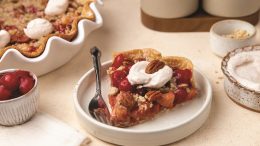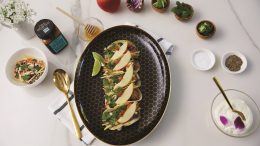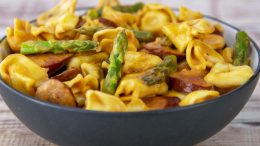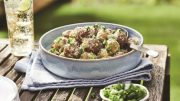Start to finish: 4 hours 50 minutes (50 minutes active)
Servings: 4
5 1/2- to 6-pound Pekin (Long Island) duck
Kosher salt and ground black pepper
1 tablespoon vegetable oil
1 small yellow onion, finely chopped
1 small carrot, coarsely chopped
2 cloves garlic, smashed with the side of a knife
1 tablespoon tomato paste
1 cup dry red wine
1 stalk celery, coarsely chopped
2 sprigs fresh thyme
1 bay leaf
3 cups low-sodium chicken broth
2 tablespoons all-purpose flour
2 tablespoons drained bottled green peppercorns, packed in brine
1 tablespoon Dijon mustard
Heat the oven to 250 F. Remove the neck and giblets from the cavity of the duck, pat dry and reserve. (Save the liver for another use, such as sauteing and serving on toast.)
Cut the last two joints of the wings off and reserve. Remove the excess fat from the cavity of the duck and cut off the flap of skin at the back end of the duck. (You can save the skin and fat to render into duck fat for future use.) Rinse the duck under cold water and pat dry with paper towels.
Using the tip of a paring knife, prick the duck all over, in 1/2-inch intervals, inserting the knife at an angle to pierce just the skin, not the flesh. Make sure to prick the skin around the leg thigh joint thoroughly, as there is a lot of fat stored there. Season the duck well with salt and pepper. Place on a rack in a roasting pan and roast on the oven’s middle shelf for 3 1/2 hours, removing the roasting pan after the first and second hour of roasting to re-prick the duck skin.
After the duck has roasted for 3 1/2 hours, carefully pour off all the fat at the bottom of the roasting pan (reserving it for other uses, such as sauteing potatoes), and increase the oven temperature to 450 F. Return the duck to the oven and roast it for 10 minutes. Transfer the duck to a platter, cover with foil, then let it rest for 30 minutes before carving.
While in the duck is roasting, cut the neck and wings into 1 1/2-inch pieces. In a large saucepan over medium-high, heat the vegetable oil. Add the neck, giblets and wings. Cook, stirring often, until golden brown, 8 to 10 minutes. Reduce the heat to medium and add the onion, carrot and garlic. Cook until the vegetables are lightly browned, 5 to 8 minutes.
Add the tomato paste and cook, stirring, for 1 minute. Add the wine and bring to a boil, stirring to pick up any browned bits on the bottom of the pan. Boil until most of the wine has evaporated. Add the celery, thyme, bay leaf, broth and 1 cup water. Bring to a boil, reduce to a simmer and cook, skimming off any scum that rises to the surface and adding water to the saucepan if the liquid dips below the bones, until the duck is ready to come out of the oven.
While the duck is resting, strain the stock and discard the solids. Measure the liquid. You should have about 1 1/2 cups. If you have more, boil the liquid down. If you have less, add water. In a small bowl, whisk together the flour and 1/4 cup water. In the saucepan, bring the duck stock to a boil, add the flour mixture in a stream, whisking. Bring the mixture back to a boil and simmer 4 minutes. Stir in the green peppercorns and mustard, then season the sauce with salt and pepper.
Carve the duck and serve each portion with some of the sauce.
Nutrition information per serving: 980 calories; 670 calories from fat (68 percent of total calories); 75 g fat (25 g saturated; 0 g trans fats); 210 mg cholesterol; 850 mg sodium; 10 g carbohydrate; 1 g fiber; 2 g sugar; 50 g protein.
Sara Moulton, Associated Press











































